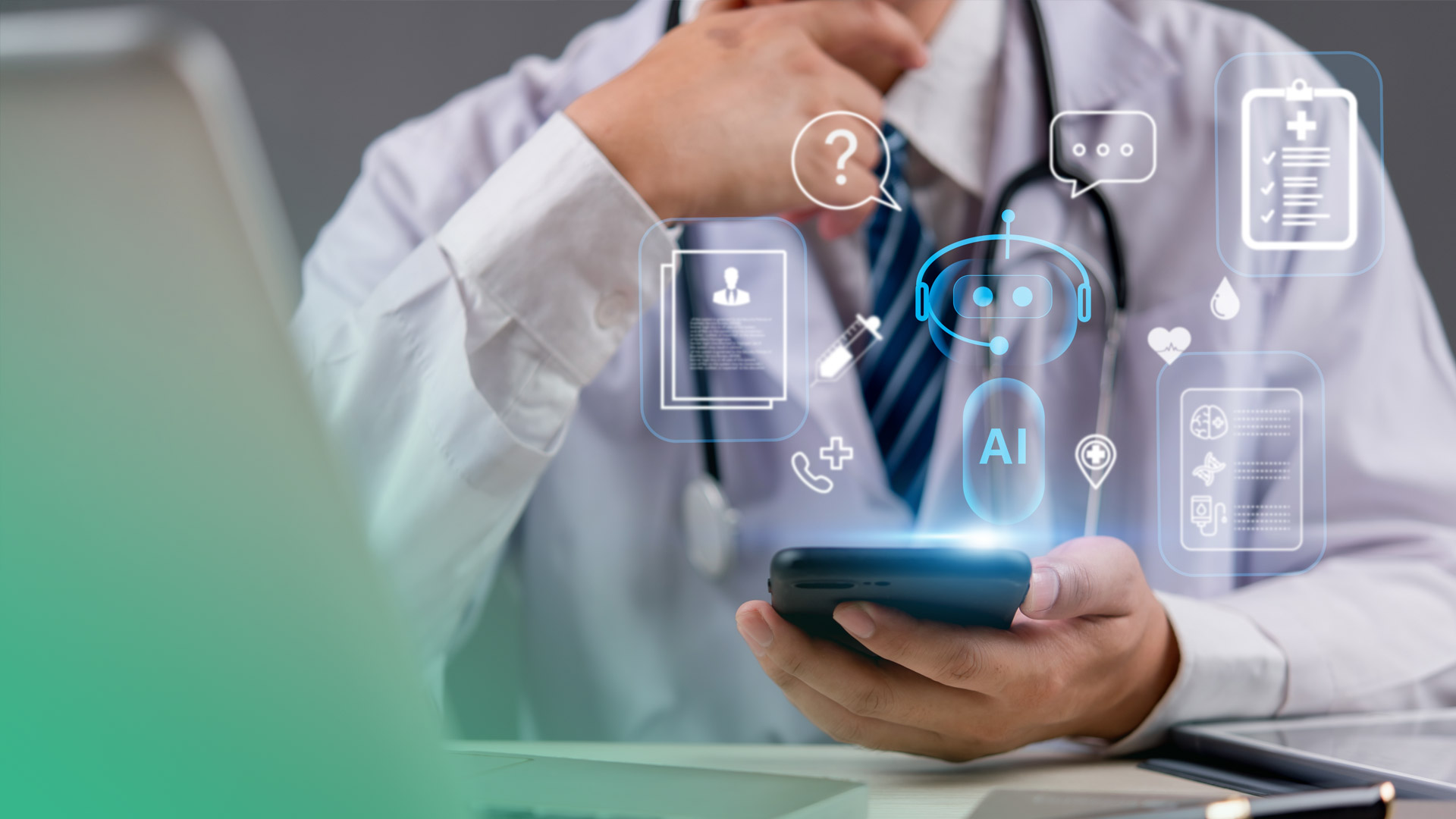
January 09, 2025
General
The Role of NLP in Medical Software for Diagnostic Assistance
The digital transformation of healthcare, through the general adoption of EHRs and EMRs since the early 2000s, has unlocked huge amounts of clinical data previously confined to medical filing cabinets. With this shift, 19 terabytes of clinical data are now generated every year.
But that technological leap also came with its own set of challenges.
A recent study revealed that 70% of physicians struggle as they have to deal with more data than they can handle. According to McKinsey, physicians spend an average of 2.6 hours daily on administrative tasks: navigating clinical notes and billing codes, reviewing medical claims, handling EHR patient documentation. This burden does not go without adding to clinician burnout and intensifying the pervasive frustration in the industry.
In today's data-saturated landscape, NLP emerges as a powerful ally that can easily turn text into meaningful insights and enable clinicians to deliver better patient care.
 To help healthcare software solutions understand human language, including meaning, intent and sentiment, NLP employs a variety of methods and techniques:
To help healthcare software solutions understand human language, including meaning, intent and sentiment, NLP employs a variety of methods and techniques:
Understanding NLP in the healthcare context
Natural Language Processing, or NLP, is a subset of Artificial Intelligence that empowers machines with the ability to comprehend and derive meaning from human language. NLP combines the field of linguistics and computer science to decipher and break down language structures, separating significant details from text and speech. In healthcare, some data come in a neatly structured format — think lab results, billing information, patient demographics data. But over 80% of medical data is unstructured in the form of physician notes, radiology reports, etc. NLP helps to connect structured and unstructured data, offering a more comprehensive perspective. For that, there are two subtasks within NLP — Natural Language Understanding (NLU) and Natural Language Generation (NLG). NLU leverages semantic and syntactic analysis of text and speech to determine the meaning of a sentence, while NLG allows machines to produce a text response based on data input. To help healthcare software solutions understand human language, including meaning, intent and sentiment, NLP employs a variety of methods and techniques:
To help healthcare software solutions understand human language, including meaning, intent and sentiment, NLP employs a variety of methods and techniques:
- Tokenization — a fundamental first step in text preprocessing and preparing it for various analytical and computational tasks. It involves breaking down a text string into smaller chunks called tokens (words, symbols, numbers, etc.) These tokens are the building blocks that form the basis for more advanced processes.
- Stemming — a process that reduces words to their stem form by stripping away common prefixes and suffixes. This “stem” is not always a valid word, but it helps group similar terms for simpler text analysis.
- Lemmatization — similar to stemming but more sophisticated. It uses dictionary-based rules to convert words into their proper base forms (lemmas). This approach preserves linguistic accuracy and is less likely to result in truncated or incorrect stems.
- Part of speech (POS) tagging — this involves assigning grammatical roles (e.g., noun, verb, adjective) to each token. By identifying a token’s role within a sentence, POS tagging helps downstream tasks like syntactic parsing.
- Named Entity Recognition (NER) – this process identifies and categorizes “named entities” like people, locations, and organizations within text. By organizing this information, NER simplifies the extraction of actionable insights from vast amounts of unstructured data.
- Sentiment analysis — analyzes text to determine the underlying emotional tone or attitude, such as positive, negative, or neutral sentiment. It is particularly useful in assessing patient feedback, monitoring patient satisfaction, and gauging emotional well-being through notes or surveys.
Enhancing efficiency and diagnostic accuracy with NLP
NLP's capability to analyze unstructured data has paved the way for transformative applications in healthcare.Medical decision support
Medical decision support systems, the cornerstone of patient-centered care, are designed to improve patient-specific assessments and assist clinicians in navigating complex decision-making processes. In 2024, the global market for these solutions was valued at $3.65 billion, with projections to exceed $8.1 billion by 2034. By integrating NLP algorithms, medical decision support systems are streamlining diagnostics. These systems analyze complex relationships among a patient’s medical history, symptoms and contextual data to suggest potential diagnosis, provide actionable recommendations, and even offer a personalized treatment plan.EHR/EMR management
NLP can enhance diagnostic workflows by making EHRs and EMRs more accurate and user-friendly, automating data extraction, and standardizing medical terminology to provide clinicians with complete and consistent patient information. This smooth approach reduces the possibility of diagnostic oversights due to fragmented or inaccurate data.Automated clinical coding and classification
NLP simplifies the task of assigning standardized codes (e.g. ICD-10 and CPT) to clinical documents by interpreting free-text entries. This reduces manual errors and accelerates the process of documentation, allowing for more accuracy in patient records and efficiency in billing.Clinical research and evidence-based medicine
NLP fast-tracks access to current medical research so that clinicians may apply current evidence to diagnostic practice. By processing large volumes of medical literature and trends, NLP does not only make diagnoses that are informed by the best knowledge available but also achieves greater accuracy and better patient outcomes.Precision medicine
Through the analysis of patient-specific data, including genetic information and clinical histories, NLP and machine learning algorithms enable the customization of treatment plans tailored to individual needs. This personalized approach enhances treatment efficacy and patient outcomes.NLP-based voice assistants
Chatbots and voice-powered assistants leverage NLP to help with preliminary diagnosis by collecting symptoms, history, and other information about their patients. These tools can lead a patient through their journey, ensuring that the patient receives timely diagnostic insights while reducing the burden for physicians. In healthcare, where every moment matters, NLP’s transformative potential is becoming indispensable. The global NLP in Healthcare & Life Sciences market is expected to surge from $2.7 billion in 2023 to $11.8 billion by 2028. If you’re ready to integrate NLP into your healthcare solutions, contact us today to discover how our expertise can help revolutionize your medical software systems.Real-life applications of NLP in healthcare
NLP Workbench for automated cancer case reporting
Central cancer registries collect data on cancer cases from various sources, often encountering unstructured or narrative text. Manually reviewing this information to identify reportable cancer cases is time-consuming and can lead to delays. To automate the identification process, the CDC and the FDA developed the NLP Workbench that relies on advanced algorithms to analyze unstructured clinical information, converting it into standardized, coded data.IBM's Watsonx Assistant for streamlining provider calls
Humana, a major health insurance provider, partnered with IBM to build a conversational voice agent with Watson. This AI-driven chatbot efficiently handles routine pre-service inquiries, such as eligibility verification and authorization information, directly addressing over 60% of provider calls that previously required human intervention.Laguna Insight to reduce administrative burdens
Laguna Health uses AI and NLP to revolutionize clinical documentation processes. Their innovative platform, Laguna Insight, automates documentation, generates intelligent summaries, and analyzes interactions between patients and care managers. By offering real-time insights from telephonic conversations, the system enhances communication, reduces administrative workloads, and allows care professionals to focus more on patient care.Overcoming challenges: Ethical and regulatory considerations
The potential of NLP in healthcare comes with the responsibility to ensure patient safety, privacy, and fairness. Biased datasets can lead to unequal outcomes, so developers must test and refine models using diverse data to eliminate bias. Safeguarding sensitive health information is equally critical, requiring compliance with regulations like HIPAA and GDPR through robust encryption, access controls, and regular audits. To build trust, NLP systems must be transparent and provide interpretable recommendations that clinicians can understand and validate. This partnership between human expertise and AI-driven insights is essential for delivering equitable and high-quality patient care.The bottom line
NLP is revolutionizing healthcare by transforming overwhelming amounts of unstructured data into actionable insights. From enhancing diagnostic accuracy with medical decision support systems to streamlining EHR management and enabling precision medicine, NLP is reshaping how care is delivered. Integrating NLP algorithms into your healthcare solutions can unlock new efficiencies, improve patient outcomes, and drive innovation. At Kanda Software, we specialize in building custom healthcare software that leverages advanced technologies like NLP. With decades of experience in digital health product development, we partner with organizations to create compliant, scalable, and user-friendly solutions tailored to their unique needs. Ready to take your healthcare software to the next level? Contact us today to discuss how Kanda Software can help bring your vision to life.Related Articles

Comprehensive AI Security Strategies for Modern Enterprises
Over the past few years, AI has gone from a nice-to-have to a must-have across enterprise operations. From automated customer service to predictive analytics, AI technologies now handle sensitive data like never before. A Kiteworks report shows that over 80% of enterprises now use AI systems that access their most critical business information. This adoption…Learn More
Building Trust in AI Agents Through Greater Explainability
We’re watching companies leap from simple automation to an entirely new economy driven by self-governing AI agents. According to Gartner, by 2028 nearly a third of business software will have agentic AI built in, and these agents will be making at least 15% of everyday work decisions on their own. While that can significantly streamline…Learn More
Healthcare Web Development: The Fastest Route to Scalable Patient Care
Outdated medical software is becoming a rising problem for healthcare facilities across the US, yet the push for digital patient experiences continues to grow. A CDC study found that 47.7% of adults ages 30-44 use the internet to communicate with a doctor or doctor's office. However, still existing paperwork, manual processes and legacy systems prolong…Learn More
RPA in Healthcare: Smarter Operations for Better Patient Care
The healthcare industry today is not only struggling with growing administrative spending but also with the increasing rates of staff burnout in healthcare facilities due to the high volume of repetitive tasks. As per Statista, 58% of registered nurses report burnout on most days, which results from both excessive emotional stress, the growing workload and…Learn More

